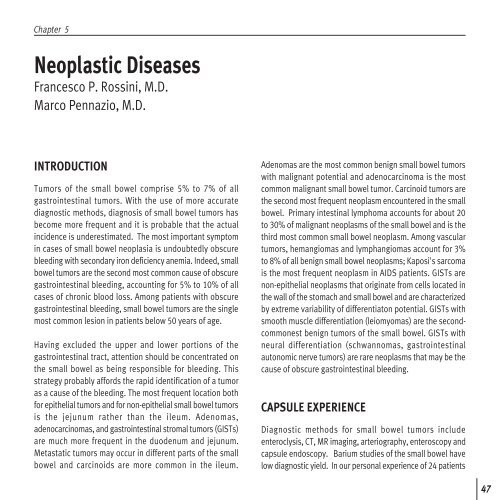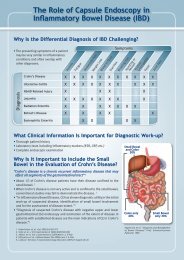capsule experience - MG Lorenzatto
capsule experience - MG Lorenzatto
capsule experience - MG Lorenzatto
You also want an ePaper? Increase the reach of your titles
YUMPU automatically turns print PDFs into web optimized ePapers that Google loves.
Chapter 5<br />
Neoplastic Diseases<br />
Francesco P. Rossini, M.D.<br />
Marco Pennazio, M.D.<br />
INTRODUCTION<br />
Tumors of the small bowel comprise 5% to 7% of all<br />
gastrointestinal tumors. With the use of more accurate<br />
diagnostic methods, diagnosis of small bowel tumors has<br />
become more frequent and it is probable that the actual<br />
incidence is underestimated. The most important symptom<br />
in cases of small bowel neoplasia is undoubtedly obscure<br />
bleeding with secondary iron deficiency anemia. Indeed, small<br />
bowel tumors are the second most common cause of obscure<br />
gastrointestinal bleeding, accounting for 5% to 10% of all<br />
cases of chronic blood loss. Among patients with obscure<br />
gastrointestinal bleeding, small bowel tumors are the single<br />
most common lesion in patients below 50 years of age.<br />
Having excluded the upper and lower portions of the<br />
gastrointestinal tract, attention should be concentrated on<br />
the small bowel as being responsible for bleeding. This<br />
strategy probably affords the rapid identification of a tumor<br />
as a cause of the bleeding. The most frequent location both<br />
for epithelial tumors and for non-epithelial small bowel tumors<br />
is the jejunum rather than the ileum. Adenomas,<br />
adenocarcinomas, and gastrointestinal stromal tumors (GISTs)<br />
are much more frequent in the duodenum and jejunum.<br />
Metastatic tumors may occur in different parts of the small<br />
bowel and carcinoids are more common in the ileum.<br />
Adenomas are the most common benign small bowel tumors<br />
with malignant potential and adenocarcinoma is the most<br />
common malignant small bowel tumor. Carcinoid tumors are<br />
the second most frequent neoplasm encountered in the small<br />
bowel. Primary intestinal lymphoma accounts for about 20<br />
to 30% of malignant neoplasms of the small bowel and is the<br />
third most common small bowel neoplasm. Among vascular<br />
tumors, hemangiomas and lymphangiomas account for 3%<br />
to 8% of all benign small bowel neoplasms; Kaposi's sarcoma<br />
is the most frequent neoplasm in AIDS patients. GISTs are<br />
non-epithelial neoplasms that originate from cells located in<br />
the wall of the stomach and small bowel and are characterized<br />
by extreme variability of differentiaton potential. GISTs with<br />
smooth muscle differentiation (leiomyomas) are the secondcommonest<br />
benign tumors of the small bowel. GISTs with<br />
neural differentiation (schwannomas, gastrointestinal<br />
autonomic nerve tumors) are rare neoplasms that may be the<br />
cause of obscure gastrointestinal bleeding.<br />
CAPSULE EXPERIENCE<br />
Diagnostic methods for small bowel tumors include<br />
enteroclysis, CT, MR imaging, arteriography, enteroscopy and<br />
<strong>capsule</strong> endoscopy. Barium studies of the small bowel have<br />
low diagnostic yield. In our personal <strong>experience</strong> of 24 patients<br />
47




